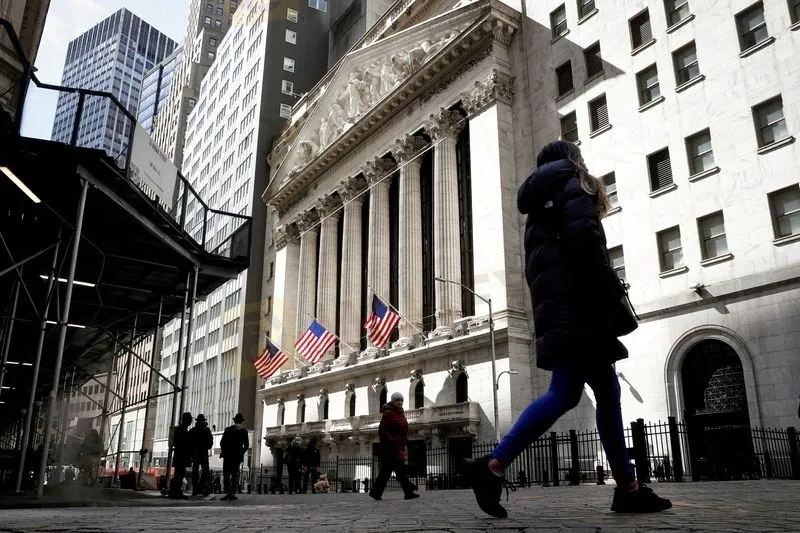Wall St slips as job openings dampen Fed pivot hopes
Abstract:Wall Street’s main indexes slipped on Tuesday after data pointed to strength in the labor market, dampening hopes that the Federal Reserve will signal an easing of its aggressive interest rate hikes.

Wall Streets main indexes slipped on Tuesday after data pointed to strength in the labor market, dampening hopes that the Federal Reserve will signal an easing of its aggressive interest rate hikes.
Data showed U.S. job openings unexpectedly rose in September, suggesting that demand for labor remains strong despite the Feds aggressive interest rate increases.
“Hopes for a Fed dovish pivot are misplaced if the previous job openings are any guide,” said Ronald Temple, head of U.S. equity at Lazard (NYSE:LAZ) Asset Management.
“Despite other signs of economic deceleration, the job openings data taken together with nonfarm payroll growth indicate the Fed is far from the point where it can declare victory over inflation and lift its foot off the economic brake.”
All three main indexes notched solid gains in October, supported by better-than-expected earnings as well as hopes that the Fed will soon shift to a less hawkish approach as economic growth slows.
Investors are bracing for a hefty 75 basis point interest rate hike at the end of the Feds two-day policy meeting on Wednesday, but will be keenly watching for signs that there could be a smaller 50 basis point interest rate hike in December.
Another report showed U.S. manufacturing activity grew at its slowest pace in nearly 2-1/2 years in October while a measure of prices paid by businesses for inputs slid for a seventh straight month.
Megcap growth companies including Amazon.com (NASDAQ:AMZN), Alphabet (NASDAQ:GOOGL) and Microsoft (NASDAQ:MSFT), which have seen pressure in recent weeks after dismal earnings, fell between 1% and 3% in morning trade.
Among S&P 500 sectors, information technology led declines, while energy continued to be a strong outperformer.
At 10:39 a.m. ET, the Dow Jones Industrial Average was down 71.34 points, or 0.22%, at 32,661.61, the S&P 500 was down 3.05 points, or 0.08%, at 3,868.93, and the Nasdaq Composite was down 14.22 points, or 0.13%, at 10,973.93.
Among single stocks, Uber Technologies (NYSE:UBER) climbed 15.7% after giving an upbeat fourth-quarter profit view that also lifted shares of its rivals Lyft Inc (NASDAQ:LYFT) and DoorDash.
Pfizer (NYSE:PFE) rose 3.1% after the drugmaker raised full-year sales estimates for its COVID-19 vaccine, while Eli Lilly (NYSE:LLY) slipped 1.1% on trimming its profit forecast.
U.S.-listed shares of Chinese firms such as JD (NASDAQ:JD).Com and Alibaba (NYSE:BABA) Group Holding jumped about 5% each following rumors based on an unverified note circulating on social media that China was planning a reopening from strict COVID-19 curbs in March.
Abiomed (NASDAQ:ABMD) surged 50.4% after Johnson & Johnson (NYSE:JNJ) said it would acquire the heart pump maker in a deal valued at $16.6 billion.
Advancing issues outnumbered decliners by a 2.75-to-1 ratio on the NYSE and 2.24-to-1 ratio on the Nasdaq.
The S&P index recorded 20 new 52-week highs and four new lows, while the Nasdaq recorded 69 new highs and 41 new lows.
Read more

Understanding the New York Forex Trading Session Time in the Philippines
The forex market operates 24 hours a day, 5 days a week, with different trading sessions that overlap and offer various trading opportunities. One of the most active trading sessions is the New York session, which plays a crucial role in the global forex market. If you're in the Philippines, understanding when the New York session overlaps with local time is essential for maximizing your trading potential.

Lirunex Joins Financial Commission, Boosts Trader Protection
Lirunex joins the Financial Commission, offering traders €20,000 protection per claim. A multi-asset broker regulated by CySEC, LFSA, and MED.

Why Your Forex Trades Are Always Losing
There is no guaranteed way to win in forex trading, but why do so many people still fail?

Capital.com Review 2025: Trading Account & Withdrawal to Explore
Despite its relative youth, the Cyprus-registered online broker Capital.com has garnered respectable attention from a large number of retail and professional investors since its 2016 launch. Capital.com is a frontrunner among low-cost trading products; it allows individual and institutional investors to trade contracts for difference (CFDs) on three thousand markets, including Forex, Stocks, Commodities, Indices, Cryptocurrencies, and more. Impressively, Capital.com is on board with ESG investments as well. You can begin trading CFDs on the Capital.com platform with as little as $20. You can trade CFDs on this platform without paying any commissions; the only fees involved are the spreads. This broker offers a wide range of platforms, including mobile apps, a desktop trading app, an API from Capital.com, Tradingview, and MetaTrader 4. Among Capital.com's many distinguishing features is the wealth of educational content and high-quality research it offers its users. The platform's Marke
WikiFX Broker
Latest News
Spotting Red Flags: The Ultimate Guide to Dodging WhatsApp & Telegram Stock Scams
WikiFX Review: Why so many complaints against QUOTEX?
Trans X Markets: Licensed Broker or a Scam?
Judge halts Trump\s government worker buyout plan: US media
BaFin Unveils Report: The 6 Biggest Risks You Need to Know
IMF Warns Japan of Spillover Risks from Global Market Volatility
Beware of Comments from the Fed's Number Two Official
RBI: India\s central bank slashes rates after five years
Nomura Holdings Ex-Employee Arrested in Fraud Scandal
Pepperstone Partners with Aston Martin Aramco F1 Team for 2025
Rate Calc


